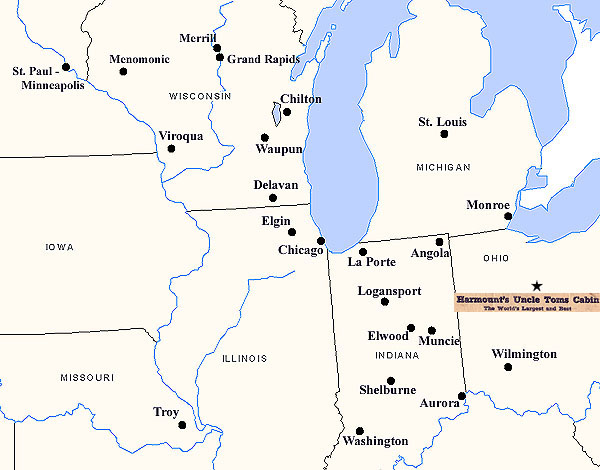

|
The 1915 correspondence between C. B. Harmount and the managers of various
theaters in 7 states can tell us something about Harmount's UTC company, and
more about the culture of popular entertainment in middle America at the time.
The star on the map above marks Harmount's headquarters in central Ohio;
clicking on it will bring up the 3 kinds of letters Harmount sent out in the
late spring, trying to secure bookings for his troupe during the coming winter
tour. In most cases he and the manager knew each other from previous tours --
sometimes too well: in Logansport, Indiana, Edw. F. Galligan expresses the hope
that this year's company "will be all on the water wagon" (i.e. not drunk). But
this year Harmount was hoping to extend the tour into new territory further
northwest, and so wrote an introductory letter to managers in Minneapolis-St.
Paul. Clicking on the dots will allow you to read the replies from 22 different managers. Many replied on the back of Harmount's original letter, but others wrote on letterhead stationary or custom-printed postcards that furnish pictures of the outside or the inside of their theaters and give us glimpse at their towns. Their words help us appreciate the context in which Harmount toured in 1915. We learn that there are many other UTC companies planning similar tours, and that while some markets are hostile to "Tom Shows," most towns look forward to one each year. We learn that some of the theaters are beginning to show movies; in fact, Shelburne, Indiana, recently showed one of the film versions of Uncle Tom "to full capacity." (The growing popularity of movies is usually cited as the reason for the near-extinction of "Tom Shows" by the end of the 1920s -- Harmount's last tour was in 1929.) We also learn a bit about the economics of trouping. When Harmount asks managers for their "best per cent," he is talking about the way the box office take will be split between the actors and the theater. 75%-25% is the most favorable split I've seen in any Harmount correspondence, with the Tommers keeping 75 cents of every dollar. Some theaters insisted on 50%-50%. And some changed the terms after the booking was made, as you can see from THIS CORRESPONDENCE concerning Orpheum Theatre in South Bend, Indiana. Below are comments from other towns, not included on the map above. One of the questions Harmount specifically asked was whether a theater played Sunday: responses to that give us a good sense of the tension between the nation's religious heritage and the growing entertainment history. La Crosse (Wisconsin) Theatre: "Sunday is our best day." |
